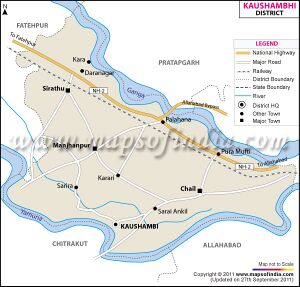Pabhosa
| Author:Laxman Burdak, IFS (R) |
Pabhosa (पभोसा) is a Village in Sarsawan Block in Kaushambi District of Uttar Pradesh State, India.
Variants
- Pabhosa (पभोसा), Pabhosi पभोसी, जिला इलाहाबाद, उ.प्र., (AS, p.528)
- Pabhosi पभोसी (AS, p.528)
- Pabosha (पभोसा)
- Pabhosha (पभोषा)
Location
Pabhosa situated on the banks of the river Yamuna. It belongs to Allahabad Division . It is located 26 KM towards South from District head quarters Manjhanpur. 9 KM from Sarasawan. 199 KM from State capital Lucknow. Pabhosa Pin code is 212214 and postal head office is Pashchim Sarira . Amina ( 3 KM ) , Badahari Uparhar ( 3 KM ) , Gorajoo ( 4 KM ) , Dhawada ( 4 KM ) , Bani Khas ( 5 KM ) are the nearby Villages to Pabhosa. Lal Gopalganj Nindaura , Chitrakoot , Allahabad , Fatehpur are the near by Cities to Pabhosa. [1]
History
Ahichchhatra appears as name of capital of Uttara Panchala. Adhichchhatra (Skt- Ahichchhatra) finds mention in Pabosha cave Inscription of Ashādhasena. [2] which may dated about beginning of Christian era. Samkhyavati was the earlier name of Ahichchhatra described as the capital of Kuru Jangala. (p.263). According to Cunninghum[3] the name is written Ahikshetra (Mbt V.252). [4]
List of monuments: S.No. N-UP-L181: Traces of a large brick building on the summit of Pabhosa hill at Pabhosa in Kaushambi.[5]
Mora Inscription of Brihaspatimitra
The Journal of Royal Asiatic Society, 1912 [6] mentions....[p.120]: Under the supervision of Pandit Radha Krishna some trial excavations were carried out on various ancient sites round Mathura out of funds provided by the Government of India. These sites include 1. Mora, 2. Ganeshra, and 3. Jaisinghpura.
The first site examined was that of Mora, 7 miles west of Mathura city, well known to epigraphists as the find-place of the so-called Mora well inscription, now in the Mathura Museum.1 The expectation that images of the Pandavas, apparently referred to in that inscription as pancha viranam pratimah (पंच वीरानां प्रतिमा:), would come to light, has not been fulfilled.2
The most important discovery made at Mora consists of eight fragments of large-sized bricks (16-1/2 by 8 by 2-1/2 in.), bearing dedicatory inscriptions in Brahmi characters of the Maurya-Sunga period. From the different fragments we obtain the following legend, in which one missing akshara has been supplied (Pl. II, Fig. 1) : Jivaputāye Rājabharyāye Brihāsvātimita [dhi] tu3 Yasha matāye kāritam (जीवपुताए राजभर्याए बृहास्वातिमित [धि] तु यश मताए कारितं), “Made by order of Yashamatā, the daughter (?) of Brihasvatimita, the king’s consort [and] the mother of living sons,”
I propose to identify the Brihasvatimita of these inscriptions with Bahasatimita (Sanskrit: Brihaspati-mitra बृहस्पतिमित्र), whose coins have been found at Kosam, about thirty miles south-west of Allahabad, and at Ramnagar (Ahichchhatra) in Rohilkhand.4 His daughter, Yashamata (यशमता), was evidently the wife of the ruler of Mathura, whose name unfortunately is not mentioned. On account of the character I feel inclined to assign these inscriptions to the third or second century B.C., which is the approximate date adopted for Bahasatimita.
1. Cf. Catalogue of the Archaeological Museum at Mathura (Allahabad, 1910), pp. 184 ff.
2. Cf. JRAS.
3. The i stroke of the syllable preceding tu is still partly preserved.
4. V. A. Smith, Catalogue of the Coins in the Indian Museum, Calcutta, Oxford, 1906, pp. 146, 155, 185.
पभोसा, पभोसी
विजयेन्द्र कुमार माथुर[7] ने लेख किया है ...पभोसा , पभोसी, जिला इलाहाबाद, उ.प्र., (AS, p.528): भरवारी स्टेशन के निकट है यहां प्रभास क्षेत्र नामक एक पहाड़ी पर एक प्राचीन जैन मंदिर है जिसका संबंध जैन तीर्थंकर पद्मप्रभु से बताते हैं. यह नगर शुंग काल में प्रभास कहलाता था. यहां से प्राप्त एक अभिलेख में शुंग वंशीय नरेश बृहस्पति मित्र (दूसरी शती ईसा पूर्व) का उल्लेख है. इस के सिक्के कौशांबी तथा अहिच्छत्र में भी मिले हैं. संभवत: मोरा ग्राम (जिला मथुरा) से प्राप्त अभिलेख में भी इसी राजा का उल्लेख है. इसकी पुत्री यशोमती मथुरा के किसी राजा को गई थी. (देखें मथुरा-संग्रहालय-परिचयपृ.8) पभोसा कोसांबी से अधिक दूर नहीं है.
पभोसा से प्राप्त अभिलेख में भी एक बृहस्पतिमित्र का उल्लेख है । इस अभिलेख की लिपि बृहस्पतिमित्र द्वितीय के मुद्रा की लिपि से तुलनीय है । काशी प्रसाद जायसवाल ने पभोसा लेख के बृहस्पतिमित्र एवं कौशाम्बी के बृहस्पतिमित्र द्वितीय को अभिन्न माना है. प्रो. वाजपेयी इस बृहस्पतिमित्र की पहचान खारवेल के हाथीगुंफा अभिलेख में उल्लिखित बृहस्पतिमित्र से करते हैं. [8]
External links
References
- ↑ http://www.onefivenine.com/india/villages/Kaushambi/Sarsawan/Pabhosa
- ↑ Luders, List (E.I. X Appendix) No.905
- ↑ The Ancient Geography of India/Ahichhatra, p.359-363
- ↑ Dr Naval Viyogi: Nagas, the Ancient Rulers of India, Delhi, 2002, pp. 263-264
- ↑ List_of_Monuments_of_National_Importance_
- ↑ The Journal of Royal Asiatic Society, 1912,p.120-123
- ↑ Aitihasik Sthanavali by Vijayendra Kumar Mathur, p.528
- ↑ Prācīna bhāratīya mudrāyeṃ (p.66) By Rajwant Rao Pradeep Kumar Rao
